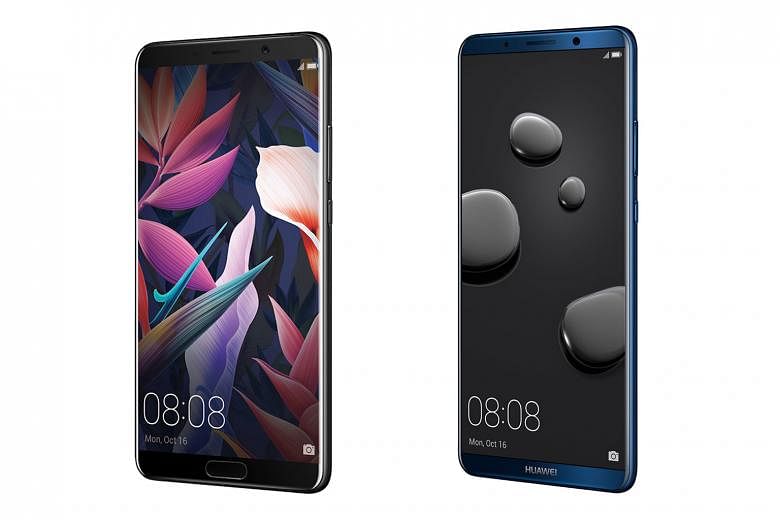Both phones in Huawei's latest Mate 10 line - the Mate 10 and the Mate 10 Pro - look and feel like different phones, even though they belong to the same family.
Despite what the naming convention may have you believe, the Mate 10 Pro is not merely a scaled-up version of the Mate 10.
The Pro looks and feels like a whole other phone, as it has a different design that is more in line with this year's flagship trends.
The $888 Mate 10 has a conventional phablet design, sporting a wide stocky body with a 5.9-inch screen that follows a 16:9 aspect ratio and a fingerprint sensor at the bottom. This gives the Mate 10 a wide, hefty feel and a more noticeable bezel.
In contrast, the Mate 10 Pro ($1,098) is much sleeker and longer, going for the contemporary 2:1 screen ratio on its 6-inch display, with a much small bezel. It also sticks the fingerprint sensor on the back, which some may prefer.
Both the Mate 10 and Mate 10 Pro sport a large 4,000mAh battery, which gives them longer life that easily stretches beyond a day. I rarely had to charge during the day as the phone would get me through till late at night.
The two phones have different screens, with the Mate 10 having a quad-HD LCD screen and the Pro sporting a slightly lower-resolution but brighter Amoled screen.
-
TECH SPECS: Huawei Mate 10 / Mate 10 Pro
-
PRICE: $888 / $1,098
PROCESSOR: Kirin 970 (Quad-core 2.36GHz, quad-core 1.8GHz) / same
DISPLAY: 5.9-inch, Quad HD, 2,560 x 1,440 pixels, 499 PPI pixel density / 6-inch, Amoled, 2,160 x 1,080 pixels, 402 PPI pixel density
OPERATING SYSTEM: EMUI 8.0 (Android 8.0) / same
CAMERA: 20MP monochrome and 12MP RGB, f/1.6 (dual lens, rear); 8MP, f/2.0 (front) / same
MEMORY: 64GB (microSD expandable up to 256GB); 4GB RAM / 128GB ; 6GB RAM
BATTERY: Non-removable 4,000 mAh / same
-
RATING (both)
-
FEATURES: 4/5
DESIGN: 4/5
PERFORMANCE: 5/5
BATTERY LIFE: 5/5
VALUE FOR MONEY: 4/5
OVERALL: 5/5
Both screens look sharp and vibrant, although the Pro can go up to a much brighter setting. The Mate 10's colour profile is cooler and more neutral compared with the Pro, which leans a little to the warm side. However, both have a colour temperature setting to customise the look to one's liking.
Local buyers of the Mate 10 will get a version with 64B of onboard storage and 4GB of RAM, but with expandable storage option via a microSD card of up to 256GB.
The Mate 10 Pro, however, lacks the option for expandable storage, which is frustrating to see in a flagship. To compensate for this, it comes with 128GB of onboard storage and 6GB of RAM.
The Mate 10 also trumps the Pro in having the all-useful 3.5mm headphone jack. Pro users will have to make do with carrying yet another dongle for audio use.
Both phones put Huawei fans in a dilemma, as opting for one means sacrificing certain features over others. I prefer the Pro due to its sleekness, and brighter and more vibrant Oled screen, but am upset about its lack of headphone jack and expandable storage.
While both phones sport a glass backing, which is notorious for attracting fingerprints, they have a nice oleophobic coating that does not show fingerprints much - a nice touch for users like me who do not like to use a phone case.
The cameras in the Mate 10 line, manufactured by famed German camera-maker Leica, are among the best in the smartphone market, closely rivalling those in industry leaders like the iPhone and Samsung's Note8.
Both phones share similar camera specs: two rear cameras, one with a 20-megapixel black-and-white sensor and the other a 12-megapixel colour sensor, along with a front-facing 8-megapixel sensor. Both phones focus quickly and have great colour accuracy, along with a host of shooting options, including a manual mode for full photographic control.
The photos produced by both are outstanding, with a few minor quibbles. The cameras are great in low light, offering lots of detail and clarity. But the phones tend to overexpose photos at times, leading to overblown images.
There is also a slight fall-off in dynamic range, so it is tricky to get great contrast in auto mode, but that can be rectified by shooting in manual mode.
Both phones also have a tendency to sharpen images, sometimes unnaturally so. It is quite pronounced on the front camera, since it is used mainly for selfies.
I look a little too unnatural in a selfie even with the beautification settings dialled down. It may turn off those who prefer accurate, true-to-life photos.
Huawei made a big deal of its new Kirin 970 processor, which the company says has a neural processing unit embedded within the chipset that lets the phone run onboard artificial intelligence.
For most users, that is not something they would immediately notice, as one of the features of the new chip is the ability to "learn" user behaviour, leading to more optimised performance weeks after they first use the phone.
I am still not a fan of Huawei's EMUI skin, with its large, square icons and chunky option bubbles. That said, the latest version of the skin, EMUI 8.0, is cleaner and less intrusive than its predecessors'.
• Verdict: The Mate 10 and Mate 10 Pro are both great phones with excellent cameras in their own right, but opting for one over the other means letting go of certain features. The conventional Mate 10 has useful features like expandable storage, but has a less sexy design, while the Pro wins stylistically, but misses out on functionality.


